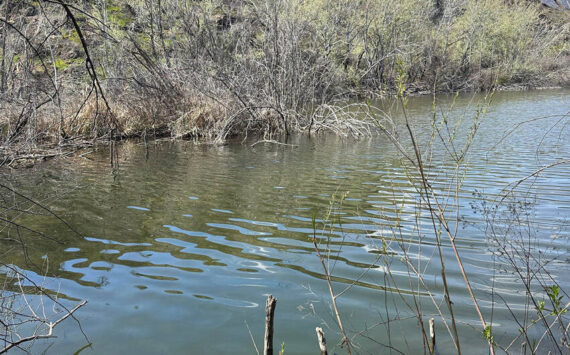OKANOGAN – The State Environmental Protection Act (SEPA) appeal against the proposed Eagle Canyon Development on Pine Creek road was denied on Tuesday, Feb. 17 during an appeal hearing with the Okanogan County Commissioners.
The appeal hearing began with Scott Detro, an Omak attorney working for the proponents of the Eagle Canyon Development, stating that Robert Harris and Tom Black, two appellants of the development, didn’t have proper standing in the appeal because they failed to comment in the original appeal. The commissioners than voted to declare Jessica McNamara, who did comment in the original appeal, as the only appellant with standing while she had the right to call on Harris and Black as witnesses or they could speak as interested parties.
Perry Huston, Okanogan County Planning Director, then spoke during the hearing, stating that the purpose of the SEPA checklist is to determine whether or not a proposal would have probable, significant and adverse impacts on the environment.
Ben Rough, senior planner, then addressed each issue outlined in the original SEPA appeal from McNamara.
According to the original appeal, issue number one states that “OCC 16.20.010 C 5 requires that a certificate of water adequacy be submitted with the application. The certificate was not submitted with the application. The application and SEPA checklist are null and void.”
“The assertion that the subdivision ordinance includes a certificate of water adequacy as part of an application is correct,” Rough said. “However, this is a nearly impossible task for applicants to achieve. Regulatory agencies, Washington State Department of Ecology (WSDOE) and Okanogan County Public Health (OKPH), do not establish water adequacy prior to an application being filed. Because of this, the Office of Planning and Development requires that applications be submitted detailing a proposed method of water withdrawal. Throughout the application review process, OKPH and WSDOE identifies whether the proposal meets legal standards or not.”
The second issue in the appeal states that “the SEPA checklist does not provide adequate information regarding water supply. OKPH and WSDOE require water rights for the project. One exempt well for all six phases of the project is allowed. The Mitigated Determination of Nonsignificance (MDNS) does not address water rights and allows exempt wells to provide water to the project.”
“WSDOE’s comment indicated that a water right is required for the project,” Rough said. “OKPH’s comment advised the proponent that a water right may be required for the project. These comments are summarized thoroughly in the MDNS and were considered for determining appropriate mitigation measures for the project. WSDOE very commonly addresses the need for a water right during the comment period. This is often followed up with a meeting with WSDOE and the proponent at which time the determination of needing a water right is overturned. The proponent for this project did have discussions with WSDOE and it was decided that eight exempt withdrawals is acceptable.”
The third issue in the appeal stated the Washington State Department of Transportation-Aviation Division (WSDOT-Aviation) recommended denial of the application due to the proposal creating too high of density surrounding the Tonasket airport.
“WSDOT-Okanogan County designates an “Airport Safety Overlay District’ around all municipal airports, including the Tonasket Airport,” Rough said in response. “This project is located within the Airport Safety Overlay. The zoning overlay does not prohibit subdivisions and does not set a base density for lands within the overlay. The MDNS includes mitigation measures that restrict the development proposal beyond what is required by the airport overlay zone. WSDOT-Aviation circulates suggested “compatible use’ guidelines that for local governments and developers to use during the planning process. These guidelines are advisory, they are not regulatory. Some of the suggested guidelines were used in the final MDNS.”
The fourth issue in the appeal stated that the traffic study of the roads which the development would connect with did not analyze the use of Tonasket Airport Road. Rough said in his response that each lot in the development must be built to the standards in the Okanogan County Road and Street Standards and Guidelines for Developments. He also said the MDNS requires this prior to final approval of each phase.
The fifth issue in the appeal stated that the MDNS didn’t evaluate the effects a high-density urban development would have in a low density area surrounded by farming operations.
“The Comprehensive Plan designation is mostly “unclassified’ with a very small portion designated as “intensive agricultural,'” Rough said. “That portion of the development area that is located within the intensive agricultural designation will be designated as open space. The zoning designation is “Minimum Requirement.’ This district allows one acre lots. The average density of the proposal is 2.9 acres per lot. Urban densities are traditionally four to eight lots per acre. This development does not propose development meeting urban densities.”
The sixth issue in the appeal was that the SEPA checklist didn’t address the construction of irrigation systems, water runoff from irrigation or erosion containment from pipeline blowouts. Rough said that the SEPA checklist did identify that an irrigation system will be in place and irrigation water will be provided to individual lots. He said the MDNS requires all final plats to identify the amount of water which will be supplied to each lot and that each have an irrigation system separate from domestic water systems.
“The Okanogan County subdivision ordinance only requires that applications be coordinated with appropriate irrigation districts,” Rough added. “This project area is not located within an irrigation district.”
Issue number seven in the appeal stated that the SEPA checklist did not mitigate moderate to high erosion hazards.
“The final MDNS requires a NPDES construction storm water permit be obtained from WSDOE,” Rough said. “This permit process requires that all sediment from construction activities be contained on-site. Also, at time of building permit, the Okanogan County Building Department regularly requires engineered building plans for structures located near steep slopes.”
The eighth issue regarded the impact to wildlife in the area not being considered in the SEPA checklist. In his response, Rough said that a portion of phase four is identified as Sharp Tailed Grouse Habitat and that the presence of priority habitats does not restrict subdivision of land.
The ninth appeal issue was that the SEPA checklist did not adequately consider transportation impacts and costs to taxpayers.
“The analysis showing a split of traffic between Tonasket Airport Road and Pine Creek Road does not take into account that it is a shorter distance to Tonasket via Tonasket Airport Road. Required road improvements are incomplete. Additional traffic on Tonasket Airport Road will require road improvements. This must be scheduled and financed,” the appeal stated.
“The SEPA checklist and Traffic Analysis propose use of the Tonasket Airport Road. The development agreement, general site plan and phase one does not address Tonasket Airport Road as an access road for the development,” Rough said in response. “The final MDNS identifies that all access roads that are used for the development must meet standards identified within “Okanogan County Road and Street Standards and Guidelines for Developments.’ There is a clear discrepancy found in these documents. All access roads used for the development, and required construction standards, should be identified prior to adoption of a development agreement.”
The tenth and final issue in the appeal stated that the SEPA checklist did not adequately address Air and Environmental Health.
“Dust mitigation was not
proposed for Tonasket Airport Road or Tonasket Terrace Road,” the appeal stated. “Airplane emissions are not addressed. Aircraft noise is not addressed. Light and glare is not adequately addressed for aircraft safety.”
Rough said that the final MDNS requires that all phase plats include a plat disclaimer that states “residential development will experience aircraft noise, light, vibration, low flying aircraft and fumes associated with normal airport operations.”
“This addresses impacts to residents deriving from living in close proximity to the airport,” he continued. “Also, all new construction is required to use non-reflective roofing materials, downcast or shielded outdoor lighting and a notice of construction must be submitted to the Federal Aviation Administration for construction of all structures. Whether stated in the MDNS or not, all activities must abide by Washington State air quality standards.”
During McNamara’s testimony, she stated that the area will never have enough water for 112 lots. She then called Harris and Black as witnesses. Harris stated that he has the senior water right on the property and that he believes there was false information on the SEPA checklist.
“The most important issue on water right is this portion is classified as family farm which means the water can only be used for crops,” Harris said.
During Black’s testimony, he said that he’s concerned the development exposes the region to the possible loss of the airport and that there would be too high of a density for the area because the original project would house up to 450 people. He also expressed concerns about erosion in the area with such a high number of farms.
Emily Rice-Townsend, representing the proponents of the Eagle Canyon Development, spoke to the commissioners next. She said that the development will not connect with Tonasket Airport Road, but will instead have dual access with North Pine Creek Road. She also addressed the concerns with the airport.
“Tonasket Homesteading recognizes the value of the airport and will follow guidelines around it,” Rice-Townsend said. “We’ve reduced the number of lots from 112 to 88. We have redone the lot layout in phase one to accommodate this reduction. We’ve increased the size of the lots to five acres each.”
DeTro then addressed the water rights issue.
“The reason water rights haven’t been transferred to the proponents is that the proponents haven’t purchased the entire land yet and the project will be done in phases,” he said.
After the proponents’ testimony, Huston spoke to the commissioners again, stating that the SEPA process has done its work for the water rights and the airport and is providing mitigations for the other issues. He stated that the appellants have failed to meet the burden of proof and recommended the appeal be denied.
After stating that they were not holding this hearing to approve or deny the proposal, the planning commissioners said they were holding the hearing simply to approve or deny the SEPA appeal. They then denied the appeal.






